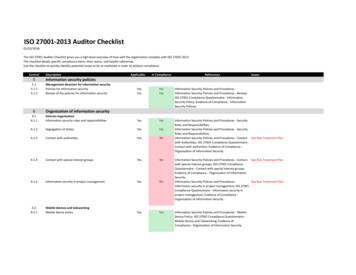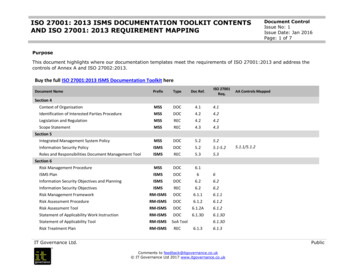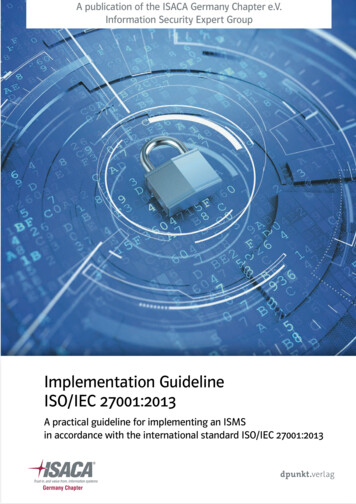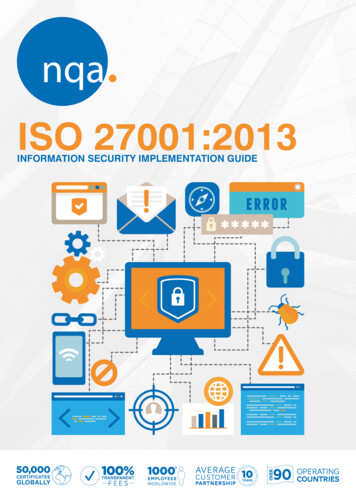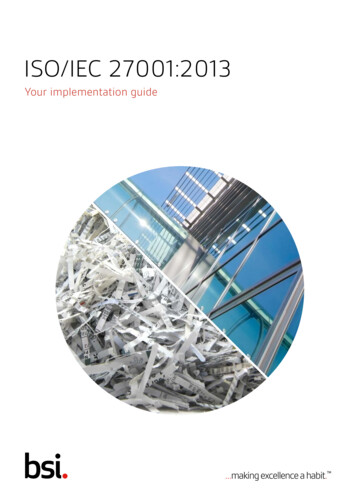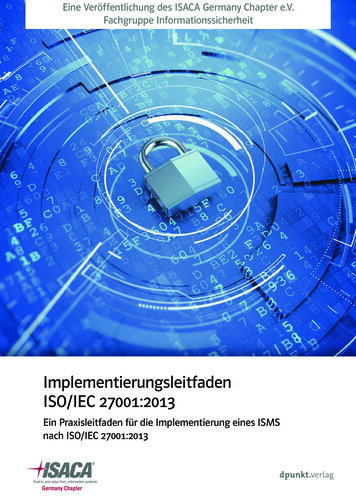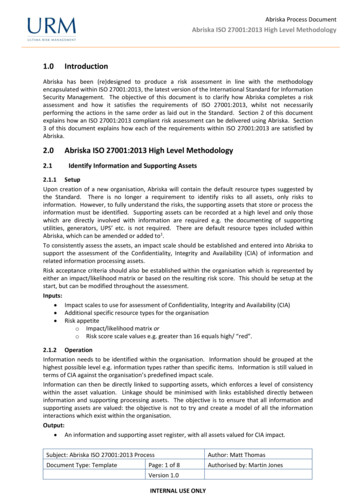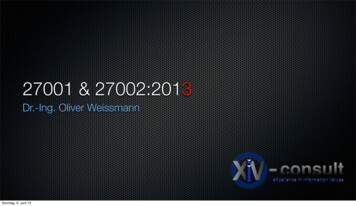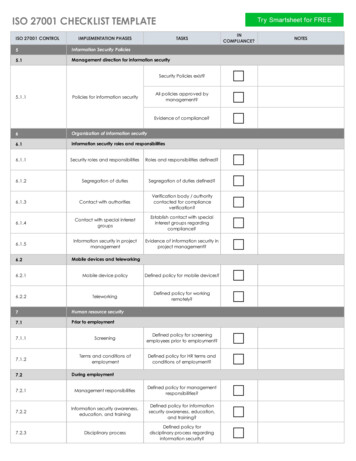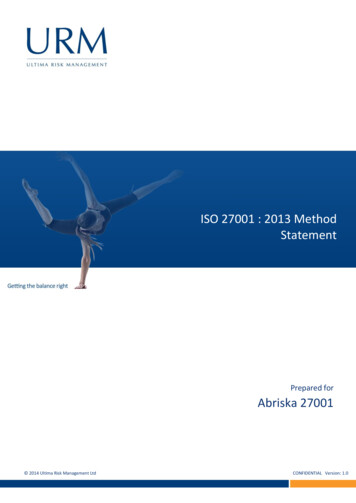
Transcription
ISO 27001 : 2013 MethodStatementPrepared forAbriska 27001 2014 Ultima Risk Management LtdCONFIDENTIAL Version: 1.0
Abriska 27001ISO 27001 : 2013 Method Statement1.0Preface1.1 Prepared ByNameMatt ThomasFunctionProduct Manager1.2 Reviewed and Authorised ByNameFunctionMartin JonesManaging Director1.3 Contact DetailsAddressUltima Place448a Basingstoke RoadReadingBerkshireRG2 0RXTelephone0118 902 74501.4 Change HistoryVersion1.0DateJuly 2014 2014 Ultima Risk Management LtdRevision DescriptionFinalCONFIDENTIAL Version: 1.0Page 1 of 16
Abriska 27001ISO 27001 : 2013 Method Statement1.0ContentsPREFACE . 11.1Prepared By . 11.2Reviewed and Authorised By . 11.3Contact Details . 11.4Change History . 12.0HIGH LEVEL METHODOLOGY . 32.1Terminology . 32.2Risk Calculation . 43.0RESOURCES, THREATS, CONTROLS AND RISKS FRAMEWORK . 53.1Resources . 53.2Threats . 53.3Controls . 53.4Mapping of Threats, Controls and Resources . 53.5Risk Register . 54.0RESOURCES. 64.1Identify Information and Information Processing Facilities. 64.2Identify Value of Resources - Business Impact Analysis . 65.0THREAT IDENTIFICATION . 85.1Threat Impact Assessment . 85.2Threat Probability Assessment . 95.3Threat Vulnerability Assessment . 96.0CONTROL MATURITY ASSESSMENT. 117.0RISK CALCULATION . 127.1Risk Calculation . 127.2Risk Appetite . 127.3Example Risk Calculation . 138.0SPECIFIC VULNERABILITIES . 159.0RISKS STATEMENTS . 16 2014 Ultima Risk Management LtdCONFIDENTIAL Version: 1.0Page 2 of 16
Abriska 27001ISO 27001 : 2013 Method Statement2.02.1High Level MethodologyTerminologyBelow is the high level methodology for completing risk assessments within Abriska for ISO 27001. Allof the terminology within Abriska is customisable, therefore navigate to the methodology page withinAbriska for a detailed breakdown of the methodology.Value (CIA)Figure 1 - High Level quenceProbabilityVulnerabilityImpact 2014 Ultima Risk Management LtdCONFIDENTIAL Version: 1.0Page 3 of 16
Abriska 27001ISO 27001 : 2013 Method StatementResource – Within Abriska, this is utilised to represent Information and Information Process Facilities– “any information processing system, service or infrastructure, or the physical location housing it”;source ISO 27000:20141. Value in terms of Confidentiality, Integrity and AvailabilityThreat – “potential cause of an unwanted incident, which may result in harm to a system ororganization”; source ISO 27000:20141. Probability – each threat is assessed in terms of how likely the threat is to occur; probabilityis based only on factors that are outside of the organisation’s control. Possible factors caninclude: Historical security events Motivation - the attractiveness of the organisation’s information resources Local circumstances – such as proximity to a threat source or number of users Capability – the ease with which this threat can be performed2. Consequence – should the threat occur there will be a loss of confidential, integrity andavailability, this value is assessed for each threatControl – “Controls include any process, policy, device, practice, or other actions which modify risk”;source ISO 27000:2014.1. Effectiveness – this is an assessment of how well the control is implemented based on amaturity model and the guidance within ISO 270022. Vulnerability – because each threat is linked to a number of controls, based on the minimumeffectiveness of these related controls a vulnerability score can be calculated.2.2Risk CalculationFor each resource threat combination a risk score is produced, using the following variables:1. Impact – Based on the related value of the resource and the consequence of the threat asingle impact score is calculated for each threat/ resource combination2. Likelihood “chance of something happening” ISO 27000:2014 – Is a measure of how likely athreat is to occur, a combination of probability and vulnerability (i.e. both and internalfactors)Risk - equals Impact multiplied by Likelihood, the risk is then mapped onto the risk appetite to give acoloured priority. Based on the relational data above, Abriska populates the risk register withgenerated risk statements. 2014 Ultima Risk Management LtdCONFIDENTIAL Version: 1.0Page 4 of 16
Abriska 27001ISO 27001 : 2013 Method Statement3.03.1Resources, threats, controls and risks frameworkResourcesWithin Abriska, the term resource is used to represent the organisations information and informationprocessing facilities (referred to as ‘information assets’ within ISO 27001:2005). There are standardresource types available, however these can be customised and added to within the system.As Abriska is used for both information security and business continuity, ‘Resource’ was used tostandardise with terminology from ISO 22301.“All assets, people, skills, information, technology (including plant and equipment), premises, andsupplies and information (whether electronic or not) that an organization has to have available to use,when needed, in order to operate and meet its objective” Source: ISO 22301:20123.2ThreatsAbriska bases risks on different threat types. The threats included in any risk assessment will varyaccording to the resource types which are subject to review. Additional threats can be added to thetool via the user interface.3.3ControlsThe base controls framework used by Abriska is that specified in ISO/IEC 27001: 2013 InformationTechnology — Security Techniques — Information Security Management Systems — Requirements(ISO 27001) thus creating an excellent base for compliance with ISO 27002 and for use on ISO 27001certification projects. Additional controls can be added to the tool via the user interface.3.4Mapping of Threats, Controls and ResourcesIn order for Abriska to provide risk assessment and risk management functionality, each of theresources that are added into the tool need to be mapped to each of the threats (e.g. are paper basedthreats affected by fire, viruses). Each of these threats are then mapped to the controls. For the baselist of resource types, threats and controls this mapping is provided by default.As a result of this mapping, any organisation adding either a new resource type, threat or control mustensure that the additional feature must be mapped (i.e. a new threat must be mapped to theappropriate control(s) or the new control mapped to the appropriate threat(s)). Failure to do thismapping will result in a loss of integrity in the risk assessment process. All of this is visible and fullycustomisable via the user interface.3.5Risk RegisterAbriska generates a risk register based on these relationships between resources, threats and controls.Abriska converts this relational data into a risk statement which can be easily presented to seniormanagement without explaining each of these concepts. 2014 Ultima Risk Management LtdCONFIDENTIAL Version: 1.0Page 5 of 16
Abriska 27001ISO 27001 : 2013 Method Statement4.0Resources4.1Identify ResourcesAll resources that need to be included in the risk assessment can easily be loaded into Abriska. Theresources should be identified in terms of the characteristics of the organisation, its location, andresources and technology. Resources that are entered should be grouped according to their riskprofile and value (in terms of confidentiality, integrity and availability). All resources need to beclassified in terms of type, the following types are provided by default: EquipmentInformation - DigitalInformation - PhysicalPeoplePremisesSuppliersTechnologyThe above types are available by default; however any number of further types can be added.Individual information resources must be separated into the above groups, for example a documentmanagement system is a piece of software with related hardware and therefore this would berepresented as two resources within Abriska. Relationships between resources can be modelledwithin Abriska.4.2Identify Value of Resources - Business Impact AnalysisThis phase of the risk assessment is used to assess business impacts that might result from breachesof security. The analysis considers the consequences of a loss of confidentiality (C), integrity (I) andavailability (A) in business terms.Business impacts should be quantitative as well as descriptive. For example, a loss of integrity maylead to fraud but this is relatively meaningless in business terms unless the extent of the potential forfraud is quantified. Each level of impact should be defined to provide a level of consistency. Thematrix used for this business impact analysis can be see within Abriska within:Organisation Resources Resource AttributesBusiness impacts should be based on realistic but worst case scenarios and ignore implementedcontrols (since an impact is potentially the result of the failure of a control).Business impact can be quantified against an individual resource or can be inherited from a relatedresource. This allows a consistent level of impact to be allocated to associated resources. For examplesuppose a document management system (DMS) sits on a server that also holds some public files(Figure 2 – Resource Inheritance). If the documents within the DMS were classified in terms of C, I andA, these values are inherited down the chain so that the application, database and server all inheritthe same BIA values. The server also inherited the public documents BIA values but would use theworst case values for use within the risk assessment. At any level of the chain the inheritance can bebroken for a specific attribute (C, I and A), to take account for a manual aggregation of impact values. 2014 Ultima Risk Management LtdCONFIDENTIAL Version: 1.0Page 6 of 16
Abriska 27001ISO 27001 : 2013 Method StatementFigure 2 – Resource ion 2014 Ultima Risk Management LtdDatabaseServerCONFIDENTIAL Version: 1.0Page 7 of 16
Abriska 27001ISO 27001 : 2013 Method Statement5.0Threat identificationThreat – “potential cause of an unwanted (information security) incident, which may result in harm toa system or organization”; source ISO 27000:2014.Abriska includes a library of threats which cover various types including technical, physical,environmental, natural disaster, people and man-made threats. These threats are linked to controlsfrom ISO 27002 and ISO 27001 so that recommendations for controls are appropriate to identifiedareas of risk. This is a vital part of the risk assessment and is a major feature of Abriska since themapping is pre-set and requires no further user intervention.Each threat could potentially cause an impact on one or more resource types and by default is mappedto the various resource types within the default library.5.1Threat Impact Assessment5.1.1How to enter impactImpacts result when vulnerabilities of resources allow threats to cause an unwanted incident thattriggers some kind of business damage. The type of damage can vary but includes direct financial loss(e.g. from a fraud), loss of reputation (e.g. due to bad publicity) and litigation (e.g. by failing to complywith data protec
(ISO 27001) thus creating an excellent base for compliance with ISO 27002 and for use on ISO 27001 certification projects. Additional controls can be added to the tool via the user interface. 3.4 Mapping of Threats, Controls and Resources In order for Abriska to provide risk assessment and risk management functionality, each of the resources that are added into the tool need to be mapped to .

